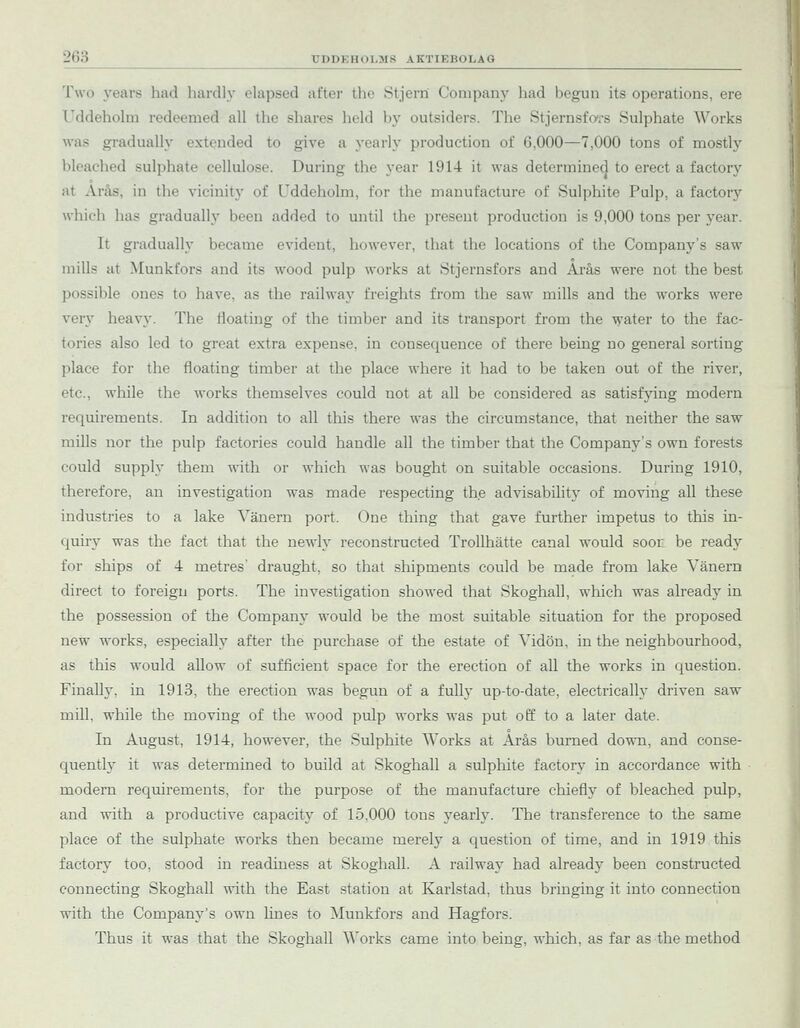
Full resolution (JPEG) - On this page / på denna sida - Illustrated monographs and map of Sweden

<< prev. page << föreg. sida << >> nästa sida >> next page >>
Below is the raw OCR text
from the above scanned image.
Do you see an error? Proofread the page now!
Här nedan syns maskintolkade texten från faksimilbilden ovan.
Ser du något fel? Korrekturläs sidan nu!
This page has never been proofread. / Denna sida har aldrig korrekturlästs.
Two years had hardly elapsed after the Stjern Company had begun its operations, ere
Uddeholm redeemed all the shares held by outsiders. The Stjernsfovs Sulphate Works
was gradually extended to give a yearly production of 6,000—7,000 tons of mostly
bleached sulphate cellulose. During the year 1914 it was determine!] to erect a factory
at Arås, in the vicinity of Uddeholm, for the manufacture of Sulphite Pulp, a factory
which lias gradually been added to until the present production is 9,000 tons per year.
It gradually became evident, however, that the locations of the Company’s saw
mills at Munkfors and its wood pulp works at Stjernsfors and Årås were not the best
possible ones to have, as the railway freights from the saw mills and the works were
very heavy. The floating of the timber and its transport from the water to the
factories also led to great extra expense, in consequence of there being no general sorting
place for the floating timber at the place where it had to be taken out of the river,
etc., while the works themselves could not at all be considered as satisfying modem
requirements. In addition to all this there was the circumstance, that neither the saw
mills nor the pulp factories could handle all the timber that the Company’s own forests
could supply them with or which was bought on suitable occasions. During 1910,
therefore, an investigation was made respecting the advisability of moving all these
industries to a lake Vänern port. One thing that gave further impetus to this
inquiry was the fact that the newly reconstructed Trollhätte canal would soor be ready
for ships of 4 metres’ draught, so that shipments could be made from lake Vänern
direct to foreign ports. The investigation showed that Skoghall, which was already in
the possession of the Company would be the most suitable situation for the proposed
new works, especially after the purchase of the estate of Vidön, in the neighbourhood,
as this would allow of sufficient space for the erection of all the works in question.
Finally, in 1913, the erection was begun of a fully up-to-date, electrically driven saw
mill, while the moving of the wood pulp works was put off to a later date.
o
In August, 1914, however, the Sulphite Works at Arås burned down, and
consequently it was determined to build at Skoghall a sulphite factory in accordance with
modern requirements, for the purpose of the manufacture chiefly of bleached pulp,
and with a productive capacity of 15,000 tons yearly. The transference to the same
place of the sulphate works then became merely a question of time, and in 1919 this
factory too, stood in readiness at Skoghall. A railway had already been constructed
connecting Skoghall with the East station at Karlstad, thus bringing it into connection
with the Company’s own lines to Munkfors and Hagfors.
Thus it was that the Skoghall Works came into being, which, as far as the method
<< prev. page << föreg. sida << >> nästa sida >> next page >>